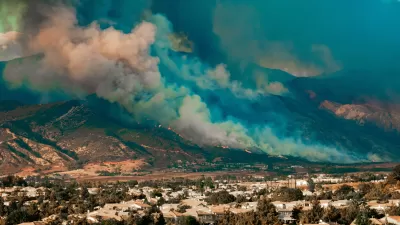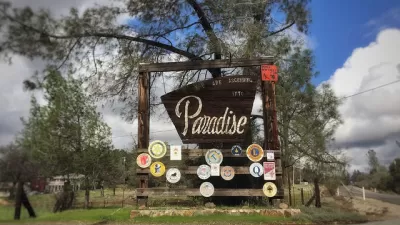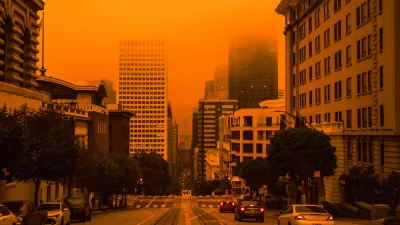A summer of drought and devastating fires has demonstrated the dangers of allowing residential developments to sprawl ever farther into wild, natural environments.
According to on article by Laura Bliss, "as we make more and more homes along the very fringes of metropolitan areas, the more we come into contact with natural habitats."
The U.S.D.A. Forest Service has a term for these fringe places: "wildland-urban interface." According to Bliss, "Putting aside conservation concerns, higher numbers in the 'wildland/urban interface' (or the “WUI,” as the U.S.D.A Forest Service calls it) means higher numbers of homes vulnerable to wildfire."
"As of 2010, 99 million people, or about one-third of all people in the United States, lived in the WUI," reports Bliss. And the map of the WUI [pdf] is expanding.
For more on the development patterns that exacerbated the fire season in California, the Los Angeles Times also published an interview by Patt Morrison of Char Miller, professor of environmental analysis at Pomona College.
FULL STORY: Mapping America's Unprecedented Vulnerability to Wildfires

Manufactured Crisis: Losing the Nation’s Largest Source of Unsubsidized Affordable Housing
Manufactured housing communities have long been an affordable housing option for millions of people living in the U.S., but that affordability is disappearing rapidly. How did we get here?

Americans May Be Stuck — But Why?
Americans are moving a lot less than they once did, and that is a problem. While Yoni Applebaum, in his highly-publicized article Stuck, gets the reasons badly wrong, it's still important to ask: why are we moving so much less than before?

Research Shows More Roads = More Driving
A national study shows, once again, that increasing road supply induces additional vehicle travel, particularly over the long run.

Judge Halts Enforcement of Anti-Homeless Laws in Grants Pass
The Oregon city will be barred from enforcing two ordinances that prosecute unhoused residents until it increases capacity and accessibility at designated camping sites.

Advancing Sustainability in Los Angeles County Schools
The Los Angeles County Office of Education’s Green Schools Symposium brings together educators, students, and experts to advance sustainability in schools through innovative design, climate resilience strategies, and collaborative learning.

Using Old Oil and Gas Wells for Green Energy Storage
Penn State researchers have found that repurposing abandoned oil and gas wells for geothermal-assisted compressed-air energy storage can boost efficiency, reduce environmental risks, and support clean energy and job transitions.
Urban Design for Planners 1: Software Tools
This six-course series explores essential urban design concepts using open source software and equips planners with the tools they need to participate fully in the urban design process.
Planning for Universal Design
Learn the tools for implementing Universal Design in planning regulations.
City of Moreno Valley
Institute for Housing and Urban Development Studies (IHS)
City of Grandview
Harvard GSD Executive Education
NYU Wagner Graduate School of Public Service
City of Cambridge, Maryland
Newport County Development Council: Connect Greater Newport





























